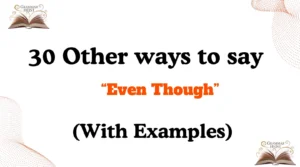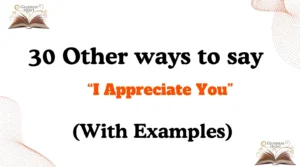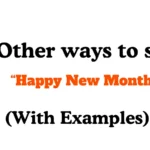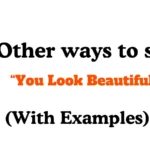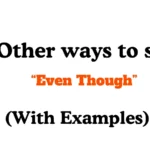When it comes to expressing empathy, the words we choose can have a significant impact. Using thoughtful and personalized phrases helps convey warmth, understanding, and compassion. Instead of the standard “I’m sorry you feel that way,” you can enrich your communication by using a variety of alternatives that show you care and acknowledge the other person’s emotions.
These alternatives can make your response feel more genuine and meaningful, especially in sensitive situations. In this article, we explore 30 ways to say “I’m sorry you feel that way,” giving you examples and insights for how to use each phrase with care.
Is It Professional/Polite to Say “I’m Sorry You Feel That Way”?
The phrase “I’m sorry you feel that way” has become somewhat formulaic in everyday conversation, but in professional or personal contexts, it can sometimes come across as dismissive if not used carefully. While it can be an expression of empathy, it’s important to make sure it’s delivered in a genuine, thoughtful tone. In many cases, using a more specific, heartfelt alternative can help avoid miscommunication and show you truly care.
Pros and Cons of Saying “I’m Sorry You Feel That Way”
Pros:
- Brief and to the point: This phrase can be a quick way to acknowledge someone’s feelings.
- Non-confrontational: It avoids taking blame directly but still shows empathy.
Cons:
- Could seem passive: The phrase might sound like you’re distancing yourself from the situation rather than taking responsibility.
- May be perceived as insincere: Without the right tone or context, it could sound dismissive.
Synonyms For “I’m Sorry You Feel That Way”:
- I Hear You, and I Understand
- I’m Sorry That This Has Upset You
- I Appreciate You Sharing Your Feelings
- I Wish I Could Make Things Better
- That Sounds Really Difficult
- I Can See Why You’d Feel That Way
- I’m Here for You
- I Want to Understand How You’re Feeling
- I Know This Isn’t Easy for You
- Your Feelings Are Completely Valid
- I’m So Sorry You’re Experiencing This
- I Can Understand Why That Would Upset You
- I Regret That This Is Happening to You
- I Wish Things Were Different for You
- It Sounds Like You’re Really Struggling
- I’m Sorry You’re Feeling This Way
- I Can’t Imagine How Hard This Must Be
- I Know This Can’t Be Easy
- I Feel So Bad for You
- It’s Clear That This Is Really Difficult for You
- I Understand Why You’d Be Feeling This Way
- My Heart Goes Out to You
- I’m Sorry You Have to Go Through This
- I Can See How Hurt You Are
- I Understand This Is Really Hard
- I’m Sorry If I Contributed to This
- I Want to Be Here for You
- This Situation Sounds Really Challenging
- I’m Sorry You’re Feeling This Way
- I Can Only Imagine How Frustrating This Must Be
1. “I Understand How You Feel”
Scenario: You want to show empathy without necessarily agreeing with the person’s perspective.
Examples:
- “I understand how you feel; I’ve been in a similar situation before.”
- “I understand how you feel, and I want to make sure we resolve this.”
- “I understand how you feel; let’s work together to fix this.”
Tone: Empathetic, supportive, validating.
Explanation: This phrase acknowledges the other person’s emotional experience and offers a connection based on understanding, showing genuine care for their feelings.
2. “That Must Be Really Tough”
Scenario: When someone is going through a difficult time and you want to empathize with their pain.
Examples:
- “That must be really tough, and I’m here to help.”
- “It sounds like that must be really tough, I can’t imagine how that feels.”
- “That must be really tough for you; I’m sorry you’re feeling this way.”
Tone: Compassionate, warm, acknowledging.
Explanation: This phrase conveys empathy and compassion while recognizing the difficulty of the other person’s emotions.
3. “I Can See Why You’d Feel That Way”
Scenario: When you want to express that the other person’s feelings are understandable from their perspective.
Examples:
- “I can see why you’d feel that way after everything that’s happened.”
- “I can see why you’d feel that way, and I’ll do my best to address it.”
- “I can see why you’d feel that way, and I want to talk through this with you.”
Tone: Understanding, reflective, empathetic.
Explanation: This phrase shows that you’re acknowledging their emotional state, highlighting that their feelings make sense based on the situation.
4. “I Wish This Hadn’t Happened”
Scenario: When you want to show regret over a situation that has caused hurt feelings.
Examples:
- “I wish this hadn’t happened; it wasn’t my intention to upset you.”
- “I wish this hadn’t happened, and I’m sorry if my actions contributed.”
- “I really wish this hadn’t happened; let’s figure out how we can fix this.”
Tone: Regretful, sincere, apologetic.
Explanation: This shows that you care about the outcome and wish things had gone differently, adding a personal layer to your empathy.
5. “I Can Only Imagine What That Must Be Like”
Scenario: When someone is expressing feelings of distress, and you want to offer your empathy without assuming you fully understand their experience.
Examples:
- “I can only imagine what that must be like for you, and I’m here to help.”
- “I can only imagine what that must be like, but I want to support you however I can.”
- “I can only imagine what that must be like, and I’m really sorry this is happening.”
Tone: Sensitive, humble, compassionate.
Explanation: This acknowledges that while you can’t fully comprehend their emotions, you understand the difficulty of the situation and want to be there for them.
6. “I’m Really Sorry You’re Going Through This”
Scenario: When someone shares a challenge or tough experience, and you want to express genuine sorrow for their situation.
Examples:
- “I’m really sorry you’re going through this; it sounds overwhelming.”
- “I’m really sorry you’re going through this; please let me know how I can help.”
- “I’m really sorry you’re going through this; I hope things get better soon.”
Tone: Warm, caring, supportive.
Explanation: This phrase conveys deep sympathy for the person’s situation while expressing a desire to offer help or support.
7. “I Feel for You”
Scenario: When you want to express solidarity and show that you are emotionally connected to the other person’s experience.
Examples:
- “I feel for you, and I’m here to listen if you need to talk.”
- “I really feel for you in this situation—it must be incredibly difficult.”
- “I feel for you, and I’m truly sorry that you’re facing this.”
Tone: Compassionate, heartfelt, validating.
Explanation: This shows that you have an emotional understanding of what the person is going through, offering support in a meaningful way.
8. “I Can Tell You’re Really Upset”
Scenario: When someone’s emotions are clearly visible, and you want to acknowledge their feelings directly.
Examples:
- “I can tell you’re really upset, and I want to help if I can.”
- “I can tell you’re really upset, and I’m sorry if something I did caused that.”
- “I can tell you’re really upset, and I understand why you’re feeling this way.”
Tone: Observant, empathetic, non-judgmental.
Explanation: This phrase helps create a space for the other person to feel seen and heard, making it easier for them to express their emotions.
9. “I Hear You”
Scenario: When you want to validate that you understand the emotions the person is expressing, even if you don’t agree with them.
Examples:
- “I hear you, and I can see why you’d feel that way.”
- “I hear you, and I know this situation is really frustrating for you.”
- “I hear you, and I want to make things better.”
Tone: Reassuring, understanding, calm.
Explanation: This phrase validates the other person’s emotions, letting them know that you’re actively listening and acknowledging their feelings.
10. “This Sounds Like a Really Hard Situation”
Scenario: When someone is dealing with a tough circumstance and you want to express empathy for their hardship.
Examples:
- “This sounds like a really hard situation, and I’m here to help.”
- “This sounds like a really hard situation, and I want to find a way to support you.”
- “This sounds like a really hard situation, and I’m so sorry it’s happening.”
Tone: Compassionate, thoughtful, empathetic.
Explanation: This shows that you recognize the difficulty of the other person’s situation and want to offer support or assistance.
11. “I’m So Sorry You’re Experiencing This”
Scenario: When someone is going through a difficult time and you want to express sympathy.
Examples:
- “I’m so sorry you’re experiencing this; I know it must be really tough.”
- “I’m so sorry you’re experiencing this; if there’s anything I can do, please let me know.”
- “I’m so sorry you’re experiencing this; I truly hope things get better soon.”
Tone: Sympathetic, warm, caring.
Explanation: This phrase acknowledges their struggle and expresses heartfelt sympathy without sounding dismissive.
12. “I Can Understand Why That Would Upset You”
Scenario: When you want to validate someone’s emotions and let them know their reaction is reasonable.
Examples:
- “I can understand why that would upset you; that sounds really frustrating.”
- “I can understand why that would upset you; I’d feel the same way in your position.”
- “I can understand why that would upset you; let’s talk about how we can fix this.”
Tone: Understanding, empathetic, validating.
Explanation: This reassures the other person that their feelings make sense, helping them feel heard and acknowledged.
13. “I Regret That This Is Happening to You”
Scenario: When someone is going through something difficult, and you want to express remorse for their situation.
Examples:
- “I regret that this is happening to you; I wish there was something I could do.”
- “I regret that this is happening to you; I know this must be painful.”
- “I regret that this is happening to you; please know that I’m here for you.”
Tone: Sincere, regretful, caring.
Explanation: This phrase expresses a deep sense of empathy and a wish that the situation were different.
Read More: 30 Other Ways to Say ‘Clean Up After Yourself (With Examples)’
14. “I Wish Things Were Different for You”
Scenario: When you want to express your hope that things improve for someone struggling.
Examples:
- “I wish things were different for you; you deserve better.”
- “I wish things were different for you; I know this must be really hard.”
- “I wish things were different for you; let me know how I can help.”
Tone: Compassionate, hopeful, supportive.
Explanation: This phrase shows care and a desire for the person’s circumstances to improve.
15. “It Sounds Like You’re Really Struggling”
Scenario: When someone is clearly having a hard time, and you want to acknowledge their pain.
Examples:
- “It sounds like you’re really struggling; I’m so sorry you’re going through this.”
- “It sounds like you’re really struggling; is there anything I can do to support you?”
- “It sounds like you’re really struggling; I’m here if you want to talk.”
Tone: Observant, empathetic, supportive.
Explanation: This phrase shows that you are paying attention to their emotions and that you care.
16. “I’m Sorry You’re Feeling This Way”
Scenario: When someone expresses distress, and you want to acknowledge their emotions.
Examples:
- “I’m sorry you’re feeling this way; I hope things get better soon.”
- “I’m sorry you’re feeling this way; let me know if I can do anything.”
- “I’m sorry you’re feeling this way; I care about you and want to help.”
Tone: Gentle, understanding, kind.
Explanation: This phrase is a softer alternative to “I’m sorry you feel that way” and conveys genuine concern.
17. “I Can’t Imagine How Hard This Must Be”
Scenario: When you want to express empathy for someone’s struggles, even if you haven’t been through the same experience.
Examples:
- “I can’t imagine how hard this must be; I’m here for you.”
- “I can’t imagine how hard this must be; you’re handling it so well.”
- “I can’t imagine how hard this must be; let’s figure out how to make things better.”
Tone: Respectful, compassionate, validating.
Explanation: This phrase acknowledges the difficulty of their emotions while showing support.
18. “I Know This Can’t Be Easy”
Scenario: When someone is going through a tough situation, and you want to acknowledge their strength.
Examples:
- “I know this can’t be easy, but I admire your resilience.”
- “I know this can’t be easy; I’m here if you need to talk.”
- “I know this can’t be easy; let me know if there’s anything I can do.”
Tone: Supportive, understanding, uplifting.
Explanation: This phrase validates the difficulty of the situation while offering support.
19. “I Feel So Bad for You”
Scenario: When someone is in pain, and you want to express deep sympathy.
Examples:
- “I feel so bad for you; I wish there was something I could do.”
- “I feel so bad for you; I know this must be really tough.”
- “I feel so bad for you; please know you’re not alone.”
Tone: Sincere, sympathetic, heartfelt.
Explanation: This phrase communicates strong empathy for the other person’s distress.
20. “It’s Clear That This Is Really Difficult for You”
Scenario: When you want to recognize someone’s struggle and offer emotional validation.
Examples:
- “It’s clear that this is really difficult for you, and I’m sorry you have to go through it.”
- “It’s clear that this is really difficult for you; I appreciate you sharing your feelings with me.”
- “It’s clear that this is really difficult for you; I want to be here for you however I can.”
Tone: Validating, compassionate, gentle.
Explanation: This phrase reassures the person that their emotions are seen and understood.
21. “I Understand Why You’d Be Feeling This Way”
Scenario: When you want to show someone that their emotions are justified.
Examples:
- “I understand why you’d be feeling this way; that must be really frustrating.”
- “I understand why you’d be feeling this way; I’d probably feel the same.”
- “I understand why you’d be feeling this way; let’s talk through this together.”
Tone: Understanding, empathetic, reassuring.
Explanation: This phrase validates emotions and helps create a more open dialogue.
22. “My Heart Goes Out to You”
Scenario: When someone is experiencing deep emotional pain, and you want to express heartfelt sympathy.
Examples:
- “My heart goes out to you; I can’t imagine how difficult this must be.”
- “My heart goes out to you; I truly wish I could make things better.”
- “My heart goes out to you; you don’t have to go through this alone.”
Tone: Deeply sympathetic, warm, comforting.
Explanation: This phrase expresses a deep level of care and concern for the other person’s emotions.
23. “I’m Sorry You Have to Go Through This”
Scenario: When someone is dealing with a difficult situation, and you want to show empathy.
Examples:
- “I’m sorry you have to go through this; it’s really unfair.”
- “I’m sorry you have to go through this; I wish I could make it easier for you.”
- “I’m sorry you have to go through this; I hope things improve soon.”
Tone: Sympathetic, caring, supportive.
Explanation: This phrase acknowledges the hardship without dismissing their feelings, offering a sense of comfort.
24. “I Can See How Hurt You Are”
Scenario: When someone is visibly upset, and you want to acknowledge their pain.
Examples:
- “I can see how hurt you are, and I want to be here for you.”
- “I can see how hurt you are; this must be incredibly painful.”
- “I can see how hurt you are, and I want to help however I can.”
Tone: Observant, validating, empathetic.
Explanation: This phrase reassures the person that their emotions are seen and understood, helping them feel acknowledged.
25. “I Understand This Is Really Hard”
Scenario: When you want to validate someone’s emotions without minimizing their struggle.
Examples:
- “I understand this is really hard, and I appreciate you sharing your feelings.”
- “I understand this is really hard, and I admire your strength.”
- “I understand this is really hard; let’s figure out how to move forward.”
Tone: Compassionate, understanding, reassuring.
Explanation: This phrase affirms that their emotions are valid and that you recognize their difficulty.
26. “I’m Sorry If I Contributed to This”
Scenario: When you suspect you may have played a role in the person’s distress and want to take responsibility.
Examples:
- “I’m sorry if I contributed to this; that was never my intention.”
- “I’m sorry if I contributed to this; I want to make things right.”
- “I’m sorry if I contributed to this; I care about your feelings.”
Tone: Apologetic, responsible, sincere.
Explanation: This phrase acknowledges your possible involvement while showing a willingness to improve the situation.
27. “I Want to Be Here for You”
Scenario: When someone is struggling, and you want to offer emotional support.
Examples:
- “I want to be here for you, no matter what you need.”
- “I want to be here for you; you don’t have to go through this alone.”
- “I want to be here for you; let me know how I can help.”
Tone: Reassuring, kind, supportive.
Explanation: This phrase emphasizes your willingness to support the person through their emotions.
28. “This Situation Sounds Really Challenging”
Scenario: When someone describes a tough experience, and you want to validate their struggle.
Examples:
- “This situation sounds really challenging; I’m sorry you’re dealing with it.”
- “This situation sounds really challenging; I hope you find some relief soon.”
- “This situation sounds really challenging; I want to help however I can.”
Tone: Understanding, compassionate, neutral.
Explanation: This phrase acknowledges the complexity of their situation without assuming their emotions.
29. “I’m Sorry You’re Feeling This Way”
Scenario: When someone is expressing frustration or sadness, and you want to acknowledge their emotions.
Examples:
- “I’m sorry you’re feeling this way; I hope things improve soon.”
- “I’m sorry you’re feeling this way; I’m here if you want to talk.”
- “I’m sorry you’re feeling this way; let me know how I can support you.”
Tone: Gentle, neutral, understanding.
Explanation: This is a softer, more empathetic way of expressing concern while leaving space for the person to share.
30. “I Can Only Imagine How Frustrating This Must Be”
Scenario: When someone is expressing frustration, and you want to validate their emotions.
Examples:
- “I can only imagine how frustrating this must be; I’m really sorry.”
- “I can only imagine how frustrating this must be; I’d feel the same way.”
- “I can only imagine how frustrating this must be; let’s see if we can find a solution.”
Tone: Empathetic, supportive, thoughtful.
Explanation: This phrase acknowledges their frustration while expressing understanding and a willingness to help.
Conclusion
The words we use can have a profound impact on how our messages are received, especially in emotionally charged situations. By replacing the typical “I’m sorry you feel that way” with more thoughtful and compassionate alternatives, you can create deeper connections and show the person you truly understand their feelings.
Whether you’re speaking in a personal or professional context, these phrases can help you communicate with warmth, care, and genuine empathy. Here is the full list of alternatives to “I’m sorry you feel that way”:

Mia Rose is a skilled language expert with a deep passion for helping individuals master the art of writing and communication. With years of experience in the field, Marie brings a thoughtful and tailored approach to grammar, style, and language improvement. Her goal is to empower others to express themselves with clarity, precision, and confidence in every written word.




